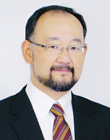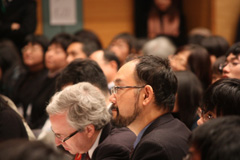Top>Opinion>The Growing Popularity of High School English Debates in Japan: Current Conditions and Issues
 Index
Index

Yoshiro Yano [profile]
The Growing Popularity of High School English Debates in Japan:
Current Conditions and Issues
Yoshiro Yano
Associate Professor, Faculty of Letters, Chuo University
Areas of Specialization: Theoretical sociology, debate education
While not yet well-known to the general public, English debates at the high school level have been spreading at an explosive rate.
The All Japan High School English Debate Tournament
The Seventh All Japan High School English Debate Tournament was held a couple of months ago, in December 2012. Students from 64 schools, representing no less than 33 prefectures from Hokkaido to Okinawa, gathered at the venue, Makuhari Sohgoh High School in Chiba Prefecture, and heated debates ensued. Due to space and administrative constraints, competitors for the All Japan Tournament are narrowed down to 64 schools, selected beforehand at tournaments held in 32 prefectures. The total number of schools that participate at all these local tournaments has risen to about 250 schools.
I have had the rare experience of being involved in the management of these tournaments since the planning stage of the First All Japan Tournament, and acted as the Chief Adjudicator for last year's tournament. The first tournament attracted only 34 schools from 17 prefectures. The number of participating schools has grown seven-fold over the intervening six years.
The Expanding English Debate Network
The name "All Japan Tournament" may lead people to mistakenly assume that it was founded in a "top-down" manner, but the tournament was actually started from scratch by volunteers. This group of volunteers eventually began calling itself the All Japan High School English Debate Association (HEnDA), but there was no organization in the beginning.
Before the All Japan Tournament was started, high school debate competitions were limited to path-breaking prefectural tournaments organized by local networks of English teachers in prefectures like Nagano and Saitama. It took a lot of charisma and individual effort to unite all these networks and establish a national tournament. For example, Mr. Junichi Miyagawa has been a particularly important driving force in expanding the network of teachers. Then a teacher at Takayama Nishi High School in Gifu prefecture, he traveled all around the country, persuading charismatic teachers in one place after another to get involved.
In this sense, you could say that the All Japan Tournament is a "bottom-up" education reform movement by the teachers. However, it has not been developed through the efforts of teachers alone; the financial and human resources support (nationwide operations and PR networks) provided by the Benesse Corporation, which has acted as a special sponsor of the tournament since its inception, has been another essential factor in rapidly expanding the base of participating schools.
The educational administration system has also played a major role in the expansion of this network by advocating the "enhancement of debating skills" in the new curriculum guidelines, among other things. It was the SELHi Program run by the Ministry of Education, Culture, Sports, Science and Technology that provided the original catalyst for the All Japan Tournament. By bringing together different high schools that were enthusiastic about English education, such as Takayama Nishi High School, it provided the foundation for the debate network. The support of local school boards has also been critical when the movement to hold debate tournaments spreads to prefectures that do not yet have prefectural tournaments. Indeed, the ability to mobilize all three sectors of industry, government, and academia has proven to be a key factor in determining the success or failure of efforts to promote these activities.
The Two Competition Formats for Academic Debates
Even Japanese adults struggle with English conversation, not to mention the fact that many of us find debating difficult-even in our own language. Thus, many teachers still think it would be hard for their students to participate in English debates.

The author (center) judging the final round
With this in mind, the tournament rules and debate format of the All Japan High School English Debate Tournament have been carefully designed to allow as many schools to participate as possible, using preceding examples from the U.S. and other countries as a guide.
There are two main competitive formats for educational debates. One is the American-style "policy debate," a format in which the debate topic is announced several months in advance and the contestants are allowed to prepare for it before the competition. The second is the British-style "parliamentary debate," a format in which the topic is announced only 20 or 30 minutes before the debate and the contestants must basically improvise their arguments. Objective arguments that draw on statistics and other forms of evidence are encouraged in American-style debates, whereas eloquence and lucidity are emphasized in British-style debates.
Since the British-style format has simple rules and requires little time or effort to prepare, it appears to be better suited for beginners. Impromptu debates, however, are actually quite difficult-even for native English speakers. In addition, there are no established judging criteria or training methods for the British-style format, making it unsuitable for the practice of scientific, objective argumentation. Due to these reasons, there are very few high schools that hold British-style debates in the U.S., the frontrunner in the field of debate education (incidentally, the National Forensic League, a national high school debate organization in the U.S. was established in 1925, and its debate tournaments attract a total of nearly 100 thousand participants each year).
With the American-style format, several documents are prepared before the competition, ensuring that even beginners have something to say on the topic. The topic is made public months in advance. Local tournaments at the prefectural level, and so on, are often held using the same topic. These make it easier for students to progress, as they debate the same topic over and over again. Indeed, the entry barrier is not that high in American-style debates. In consideration of these facts, the All Japan Tournament adopted the American-style format.
Designing the Debate Tournament
The American-style format, however, includes several different variants. Some American debates at the university level have become too specialized, with contestants listing off technical terms at a speed the general public cannot follow. To avoid this situation, various devices for preventing the tournament from getting too extreme were included in the creation of the All Japan Tournament. For example, the team aspect of the competition was emphasized, a new four-member team format was developed, and restrictions were added to the role of the speaker. Limits were also set on the number of issues and types of arguments allowed.
These devices have been effective in not only enabling a large number of schools to participate, but also improving the quality of the debates with surprising speed. While, at first glance, imposing restrictions on debates might seem to hinder free discussion, it could be argued that a moderate reduction in freedom (complexity) is essential when learning how to debate.
In general, competitive debating can act as an incentive for students to engage in independent learning. If overdone, however, students may become obsessed with the idea that winning is everything, leading to rampant irregularities and a strained atmosphere at the tournament.
To prevent this from happening, an emphasis has been placed on promoting the tournament's "Make friends" ideal from the very beginning. The real goal of the debate tournament is for everyone involved (teachers included) to grow as human beings through their participation in the tournament, while the competitive aspect of the debates is simply the means to achieve this goal. A "Make-Friends Pledge" has been drawn up to thoroughly implement this ideal, and all the participants recite the pledge in English during the opening ceremony. A variety of other measures have also been implemented to ensure that the tournament is not focused solely on winning and losing. For example, group photos of all the participants are taken and a banquet attended by all the high school students is held. The organizers spend a lot of time and energy for these social events.
The Role of Universities in the Spread of High School Debates
Judging from the growth of the tournament, we can see that this design has been effective so far, and that the English debate network is expanding. However, there are still many more contributions that need to be made by the afore-mentioned sectors of industry, government and academia-and, in particular, universities-for this growth to last beyond a fleeting craze, and for practical English education and debate education to take hold in Japan.
At American universities, there are courses that specialize in speech communication and debate education, where full-time professors build students' debating skills and focus on training them into future debate coaches. Harvard University holds an annual high school debate tournament, with a total of 38 tournaments held to date. I got the chance to observe the tournament last year. I understand it is one of the largest high school debate tournaments in the U.S., and it made full use of the university campus, with fourteen different departments hosting the tournament at the same time. Fueled by ambitions to become members of the elite, the high school students engaged in lively debates.
Japanese high school students are hardly less formidable debaters. They debated the pros and cons of "starting the academic year at universities in September," the topic for last year's All Japan Tournament. It was thrilling to watch them tear apart articles written by professors, making arguments in English that they contained "no proof!".
I am inclined to say that the spread of English debates will not only trigger the reformation of English education in Japan, but may even lead to the reformation of our insular society.
- Yoshiro Yano
Associate Professor, Faculty of Letters, Chuo University
Areas of Specialization: Theoretical sociology, debate education - Professor Yano was born in 1968. He graduated with a bachelor's degree in sociology from the Faculty of Letters, the University of Tokyo and earned a Ph.D. in sociology from the Graduate School of Sociology at the same university. After working as a Research Associate at the University of Tokyo, he started teaching at the Faculty of Letters, Chuo University in 2003. He specializes in theoretical sociology (with an emphasis on Max Weber's sociology) and debate education. In addition to his main work, he has been involved in volunteer activities that promote debate education since his days as an undergraduate, and has served as a director of the Japan Debate Association since 1991 (he was the President of the association from 2004 to 2011).
- Research Activities as a Member of Research Fellowship for Young Scientists (DC1), Japan Society for the Promotion of Science (JSPS) Shuma Tsurumi
- Important Factors for Innovation in Payment Services Nobuhiko Sugiura
- Beyond the Concepts of Fellow Citizens and Foreigners— To Achieve SDGs Goal 10 “Reduce Inequality Within and Among Countries” Rika Lee
- Diary of Struggles in Cambodia Fumie Fukuoka
- How Can We Measure Learning Ability?
—Analysis of a Competency Self-Assessment Questionnaire— Yu Saito / Yoko Neha - The Making of the Movie Kirakira Megane








